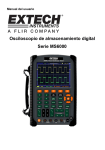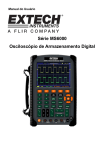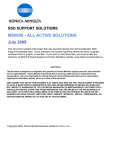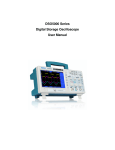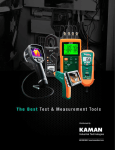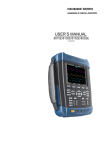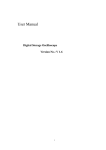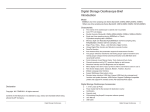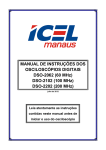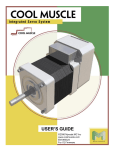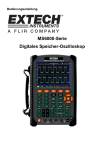Download Manual - Extech Instruments
Transcript
User Manual MS6000 Series Digital Storage Oscilloscope Chapter 1 – Contents CHAPTER 1 - CONTENTS ........................................................................................2 1.1 GENERAL SAFETY SUMMARY ...............................................................................5 1.2 SAFETY TERMS AND SYMBOLS .............................................................................6 1.3 TERMS ON PRODUCT ............................................................................................6 1.4 SYMBOLS ON PRODUCT ........................................................................................6 1.5 PRODUCT AND BATTERY DISPOSAL ......................................................................7 CHAPTER 2 2.1 - OVERVIEW ........................................................................................8 BRIEF INTRODUCTION ON MS6000 SERIES ..........................................................8 CHAPTER 3 - GETTING STARTED GUIDE...........................................................9 3.1 INSTALLATION ......................................................................................................9 3.2 FUNCTIONAL CHECK ............................................................................................9 3.3 POWER ON THE OSCILLOSCOPE ............................................................................9 3.4 CONNECT THE PROBE TO THE OSCILLOSCOPE .......................................................9 3.5 OBSERVING A WAVEFORM ...................................................................................10 3.6 PROBE EXAMINATION.........................................................................................10 3.7 SAFETY ..............................................................................................................10 3.8 MANUAL PROBE COMPENSATION .......................................................................11 3.9 PROBE ATTENUATION SETTING...........................................................................12 3.10 SELF CALIBRATION ............................................................................................12 3.11 MULTIFUNCTION CONTROL ................................................................................12 - MAIN FEATURES ...........................................................................................................13 3.12 OSCILLOSCOPE SETUP ........................................................................................13 3.13 TRIGGER ............................................................................................................13 3.14 DATA ACQUISITION ............................................................................................15 3.15 WAVEFORM SCALING AND POSITIONING ............................................................16 3.16 WAVEFORM MEASUREMENT ...............................................................................17 2 MS6000-EU-EN V1.4 8/12 CHAPTER 4 4.1 DISPLAY AREA ...................................................................................................20 4.1.1 4.2 XY Format ...............................................................................................22 HORIZONTAL CONTROLS ....................................................................................23 4.2.1 4.3 - BASIC OPERATION .......................................................................19 Scan Mode Display (Roll Mode)...........................................................26 VERTICAL CONTROLS .........................................................................................26 4.3.1 Math FFT .................................................................................................29 4.3.1.1 Setting Time-domain Waveform ....................................................................... 29 4.3.1.2 Displaying FFT Spectrum................................................................................. 31 4.3.1.3 Selecting FFT Window ..................................................................................... 32 4.3.1.4 FFT Aliasing ..................................................................................................... 34 4.3.1.5 Eliminating Aliases ........................................................................................... 34 4.3.1.6 Magnifying and Positioning FFT Spectrum................................................. 35 4.3.1.7 Using Cursors to Measure FFT Spectrum......................................................... 35 4.4 TRIGGER CONTROLS ..........................................................................................37 4.5 MENU AND OPTION BUTTONS ............................................................................46 4.5.1 SAVE/RECALL .......................................................................................46 4.5.2 MEASURE...............................................................................................48 4.5.3 CURSOR .................................................................................................50 4.5.4 UTILITY....................................................................................................51 4.5.5 DISPLAY..................................................................................................55 4.5.6 ACQUIRE ................................................................................................56 4.5.7 Fast Action Buttons ................................................................................58 4.5.8 AUTOSET................................................................................................58 CHAPTER 5 - MULTIMETER OPERATION..........................................................60 CHAPTER 6 - TROUBLESHOOTING ...................................................................73 6.1 PROBLEM SOLVING ............................................................................................73 CHAPTER 7 7.1 - SPECIFICATIONS...........................................................................74 TECHNICAL SPECIFICATIONS ..............................................................................74 3 MS6000-EU-EN V1.4 8/12 CHAPTER 8 - GENERAL CARE AND CLEANING.............................................87 8.1 GENERAL CARE ..................................................................................................87 8.2 CLEANING ..........................................................................................................87 4 MS6000-EU-EN V1.4 8/12 - Safety Tips 1.1 General Safety Summary Read the following safety precautions to avoid injury and prevent damage to this product or any products connected to it. To evade potential hazards, use this product only as specified. Only qualified personnel should perform maintenance. Avoid fire or personal injury. Use suitable power cord. Use only the power cord specified for this product and certified for the country of use. Connect and disconnect properly. Connect a probe with the oscilloscope before it is connected to measured circuits; disconnect the probe from the oscilloscope after it is disconnected from measured circuits. Ground the product. This product is grounded through the grounding conductor of the power cord. To avoid electric shock, the grounding conductor must be connected to earth ground. Before making connections to the input or output terminals of the product, ensure that the product is properly grounded. Connect the probe in a right way. The probe ground lead is at ground potential. Do not connect the ground lead to an elevated voltage. Check all terminal ratings. To avoid fire or shock hazard, check all ratings and markings on the product. Refer to the product manual for detailed information about ratings before making connections to the product. Do not operate without covers. Do not operate this product with covers or panels removed. Avoid exposed circuitry. Do not touch exposed connections and components when power is present. Do not operate with suspected failures. If damage to this product is suspected, have it inspected by qualified service personnel. Assure good ventilation. Do not operate in wet/damp environments. Do not operate in an explosive atmosphere. Keep product surfaces clean and dry. 5 MS6000-EU-EN V1.4 8/12 1.2 Safety Terms and Symbols The following terms may appear in this manual: WARNING Warning statements point out conditions or practices that could result in injury or loss of life. CAUTION Caution statements identify conditions or practices that could result in damage to this product or other property. 1.3 Terms on Product The following terms may appear on the product: DANGER indicates an injury hazard immediately accessible as the marking is read. WARNING indicates an injury hazard not immediately accessible as the marking is read. CAUTION indicates a possible hazard to this product or other property. 1.4 Symbols on Product The following symbols may appear on the product: Protective Ground (Earth) Terminal Mains Disconnected OFF (Power) Measurement Ground Terminal Mains Connected ON (Power) CAUTION Refer to Manual Measurement Input Terminal High Voltage 6 MS6000-EU-EN V1.4 8/12 1.5 Product and Battery Disposal Battery Recycling and Disposal You, as the end user, are legally bound (EU Battery ordinance) to return all used batteries, disposal in the household garbage is prohibited! You can hand over your used batteries / accumulators at collection points in your community or wherever batteries / accumulators are sold! Disposal: Follow the valid legal stipulations in respect of the disposal of the device at the end of its lifecycle 7 MS6000-EU-EN V1.4 8/12 Chapter 2 - Overview 2.1 Brief Introduction on MS6000 Series Model Channels Bandwidth Sample Rate LCD MS6060 2 60MHz 1GS/s 5.6 inch color MS6100 2 100MHz 1GS/s 5.6 inch color MS6200 2 200MHz 1GS/s 5.6 inch color Table 2-1 Model List of MS6000 Series MS6000 Series oscilloscopes bandwidths range from 60MHz to 200MHz, and provide real-time and equivalent sample rates respectively up to 1GSa/s and 25GSa/s. In addition, they have maximum 1MB memory depth for better observation of the waveform details, and 5.6 inch color TFT LCD as well as WINDOWS-style interfaces and menus for easy operation. Additionally, the generous menu information and the easy-to-operate buttons maximize the information available for each measurement; the multifunctional and powerful shortcut keys save time and maximize efficiency; the Autoset (AUTO) function allows the user to detect sine and square waves automatically. 8 MS6000-EU-EN V1.4 8/12 Chapter 3 - Getting Started Guide 3.1 Installation To keep proper ventilation of the oscilloscope in operation, leave a space of more than 5 cm (2”) from the top and the two sides of the product. 3.2 Functional Check Follow the steps below to perform a quick functional check to your oscilloscope. 3.3 Power ON the oscilloscope Press the ON/OFF button. The start-up sequence will take up to 15 seconds to complete. NOTE: The AC Charger is intended for battery charging only. Use of charger during measurements is not recommended. The default probe parameter 3.4 Connect the Probe to the oscilloscope Set the switch on the probe to 10X and connect the probe to the Channel 1 BNC on the oscilloscope. Connect the probe tip to the 1 KHz Probe Compensation connector and the reference lead to the Ground connector. The CH1 default Probe option attenuation setting is 1X, change this to 10X. Connect Probe tip to 1-KHz Channel 1 Probe Connection signal when compensating Ground connection for reference lead when compensating 9 MS6000-EU-EN V1.4 8/12 3.5 Observing a waveform Press the AUTO button and a 1 KHz square wave of approx. 5V peak-to-peak will appear in the display. Press the CH1 button and remove Channel 1. Move the Probe to the CH2 BNC, push the CH2 button and repeat these steps to observe the test signal on Channel 2. 3.6 3.7 Probe Examination Safety When using the probe, keep fingers behind the guard on the probe body to avoid electric shock. Do not touch metallic portions of the probe head while it is connected to a voltage source. Connect the probe to the oscilloscope and connect the ground terminal to ground before starting any measurements. 10 MS6000-EU-EN V1.4 8/12 3.8 Manual Probe Compensation Upon the first connection of a probe to an input channel, manually perform this adjustment to match the probe to the input channel. Uncompensated probes may lead to errors or faults in measurement. To adjust the probe compensation, follow the steps below. 1. Set the switch on the probe to 10X and connect the probe to Channel 1 on the oscilloscope. Attach the probe tip to the PROBE COMP ~5V@1KHz connector and the reference lead to the PROBE COMP Ground connector. Press CH1 button and set the Probe attenuation to 10X. Press the AUTO button and you should see the 1 KHz reference signal. 2. Check the shape of the displayed waveform. Compensated correctly Overcompensated Undercompensated 3. If necessary, use a nonmetallic screwdriver to adjust the variable probe capacitor until the shape of the waveform appears to be the same as shown in the above figure. Repeat this step as necessary for additional probes. Refer to the figure below for adjustment illustration. 11 MS6000-EU-EN V1.4 8/12 3.9 Probe Attenuation Setting Probes are of various attenuation factors which affect the vertical scale of the signal. Ensure that the attenuation switch on the probe matches the CH probe option in the oscilloscope. Switch settings are 1X and 10X. To set the probe attenuation to match the probe setting, push the vertical menu button (such as the CH1 button) and select the probe option that matches the attenuation factor of the probe in use. When the attenuation switch is set to 1X, the probe limits the bandwidth of the oscilloscope to 6MHz. To use the full bandwidth of the oscilloscope, be sure to set the switch to 10X. 3.10 Self Calibration The self calibration routine helps optimize the oscilloscope signal path for maximum measurement accuracy. The routine can be run at any time but should always be run if the ambient temperature changes by 5°C or more. For an accurate calibration, please power on the oscilloscope and wait 20 minutes before performing the Self calibration. To compensate the signal path, disconnect any probes or cables from the front-panel input connectors. 3.11 Multifunction Control The Multifunction Control arrows are used to move the cursors and change menu item settings. 12 MS6000-EU-EN V1.4 8/12 - Main Features This chapter provides some general information the user should be aware of before using this oscilloscope. It contains: 4.1 Oscilloscope setup 4.2 Trigger 4.3 Data Acquisition 4.4 Waveform scaling and positioning 4.5 Waveform measurement 3.12 Oscilloscope Setup While operating the oscilloscope, the AUTOSET feature will, in most cases, be used. Autoset: This function can be used to adjust the horizontal and vertical scales of the oscilloscope automatically and set the trigger coupling, type, position, slope, level and mode, etc., to acquire a stable waveform display. Press the AUTO button to engage Autoset. 3.13 Trigger The trigger determines when the oscilloscope begins to acquire data and display a waveform. Once a trigger is properly set up, the oscilloscope can convert unstable displays or blank screens to meaningful waveforms. Basic information regarding triggering is provided below. Trigger Source: The trigger can be generated from either CH1 or CH2. The input channel can trigger normally whether or not the input signal is displayed. Trigger Type: The oscilloscope has six types of triggers: Edge, Video, Pulse Width, Slope, Overtime, and Alter. Press the TRIG button to engage this feature. Edge Trigger Triggering occurs when the input trigger source crosses a specified level in a specified direction. Video Trigger performs a field or line trigger through standard video signals. Pulse Width Trigger can trigger normal or abnormal pulses that meet trigger conditions. Slope Trigger uses the rise and fall times on the edge of a signal for triggering. Overtime Trigger occurs after the edge of a signal reaches the set time. Alter Trigger uses a specific frequency to switch between two analog channels (CH1 and CH2), so that the channels will generate swap trigger signals. 13 MS6000-EU-EN V1.4 8/12 Slope and Level: (Set Trig Type to Edge or Slope) The Slope and Level controls help to define the trigger. The Slope option determines whether the trigger point is on the rising or falling edge of a signal. To perform the trigger slope control, press the TRIG button and then select Edge trigger (F1), and use the Slope button (F3) to select rising or falling. The LEVEL button controls where the trigger point is on the edge. Trigger level can be adjusted vertically Rising Edge Falling Edge Trigger slope can be rising or falling Trigger Mode: (Auto, Normal, Single) Select the Auto or Normal mode to define how the oscilloscope acquires data when it does not detect a trigger condition. Auto Mode performs the acquisition freely in absence of valid trigger. It allows the generation of untriggered waveforms with the time base set to 80ms/div or slower. Normal Mode updates the displayed waveforms only when the oscilloscope detects a valid trigger condition. Before this update, the oscilloscope continues to display the older waveforms. This mode should be used when it is desired to only view the effectively triggered waveforms. In this mode, the oscilloscope displays waveforms only after the first trigger. Single mode will allow you to view a Single sweep of a waveform. Trigger Coupling: (AC, DC, Noise Reject, HF Reject, LF Reject) Trigger Coupling determines which part of the signal will be delivered to the trigger circuit. This can help to obtain a stable display of the waveform. To use trigger coupling, push the TRIG button, select Edge, Pulse, Slope, or O.T. trigger, and then press F5 for page 2 and select a Coupling option. Trigger Position: The horizontal position control establishes the time between the trigger position and the screen center. 14 MS6000-EU-EN V1.4 8/12 3.14 Data Acquisition When an analog signal is acquired, the oscilloscope will convert it to a digital one. There are two kinds of acquisitions: Real-time acquisition and Equivalent acquisition. The real-time acquisition has three modes: Normal, Peak Detect, and Average. The acquisition rate is affected by the time base. Real-Time Acquisition: Normal: In this mode, the oscilloscope samples the signal in evenly spaced intervals to establish the waveform. This mode accurately represents signals in most instances. However, it does not acquire rapid variations in the analog signal that may occur between two samples, which can result in aliasing and may cause narrow pulses to be missed. In such cases, use the Peak Detect mode to acquire data. Peak Detect: In this mode, the oscilloscope obtains the maximum and minimum values of the input signal over each sample interval and uses these values to display the waveform. In this way, the oscilloscope can acquire and display narrow pulses that may have otherwise been missed in Normal mode. However, noise will appear to be higher in this mode. Average: In this mode, the oscilloscope acquires several waveforms, averages them, and displays the resulting waveform. Use this mode to reduce random noise. Equivalent Acquisition: This type of acquisition can be utilized for periodic signals. In case the acquisition rate is too low when using the real-time acquisition, the oscilloscope will use a fixed rate to acquire data with a stationary (very small) delay after each acquisition of a frame of data. After repeating this acquisition for N times, the oscilloscope will arrange the acquired N frames of data by time to make up a new frame of data; and then the waveform can be recovered. The number of times (N) is related to the equivalent acquisition rate. Time Base: The oscilloscope digitizes waveforms by acquiring the value of an input signal at discrete points. The time base helps to control how often the values are digitized. Use the TIME/DIV button to adjust the time base to a horizontal scale that suits your requirements. 15 MS6000-EU-EN V1.4 8/12 3.15 Waveform Scaling and Positioning The display of waveforms on the screen can be changed by adjusting their scale and position. Once the scale changes, the waveform display will increase or decrease in size. Once the position changes, the waveform will move up, down, right, or left. The channel reference indicator (located on the left of the graticule) identifies each waveform on the screen. It points to the ground level of the waveform record. Vertical Scale and Position: The vertical position of a waveform can be changed by moving it up or down on the screen. To compare data, align one waveform over another. Horizontal Scale and Position: Pretrigger Information The HORIZONTAL POSITION control can be adjusted to view waveform data before the trigger, after the trigger, or some of each. When the horizontal position of a waveform is changed, the time between the trigger position and the screen center is being changed. For example, to find the cause of a glitch in a test circuit, trigger on the glitch and make the pre-trigger period long enough to capture data before the glitch. Then analyze the pre-trigger data and perhaps find the cause. Change the horizontal scale of all the waveforms by clicking the TIME/DIV button; for example, to see just one cycle of a waveform to measure the overshoot on its rising edge. The oscilloscope shows the horizontal scale as time per division in the scale readout. Since all active waveforms use the same time base, the oscilloscope only displays one value for all of the active channels. 16 MS6000-EU-EN V1.4 8/12 3.16 Waveform Measurement The oscilloscope displays graphs of voltage versus time (YT) and can help to measure the displayed waveform. There are several ways to take measurements, using the graticule, the cursors or performing an automatic measurement. Graticule: This method allows a quick, visual estimate and takes a simple measurement through the graticule divisions and the scale factor. For example, the user can take simple measurements by counting the major and minor graticule divisions involved and multiplying by the scale factor. If 6 major vertical graticule divisions are counted between the minimum and maximum values of a waveform and a scale factor of 50mV/division is selected, the peak-to-peak voltage can be calculated as follows: 6 divisions x 50mV/division = 300mV. Cursor: This method allows the user to take measurements by moving the cursors. Cursors always appear in pairs and the displayed readouts are just their measured values. There are two types of cursors: Amplitude Cursor and Time Cursor. The amplitude cursor appears as a horizontal broken line, measuring the vertical parameters. The time cursor appears as a vertical broken line, measuring the horizontal parameters. When using the cursors please set the Source parameter to the desired waveform. To use cursors, push the CURSOR button. Cursor Cursor 17 MS6000-EU-EN V1.4 8/12 Automatic Measurement: The oscilloscope performs all of the calculations automatically in this mode. As this measurement uses the waveform record points, it is more precise than the graticule and cursor measurements. Automatic measurements show the measurement results by readouts which are periodically updated with the new data acquired by the oscilloscope. To use the Measurement mode push the MEAS button. 18 MS6000-EU-EN V1.4 8/12 Chapter 4 - Basic Operation The front panel of the oscilloscope is divided into several functional areas. A quick overview of all control buttons on the front panel as well as the displayed information on the screen and relative testing operations is provided in this chapter. The figure below illustrates the front panel of the MS6000 series digital oscilloscope. Front Panel of the MS6000 Series 19 MS6000-EU-EN V1.4 8/12 4.1 1. Display Area Display Format: : YT : XY : Vectors : Dots : Gray indicates auto persistence; Green indicates persistence display is enabled. When the icon is set to green, the time for persistence display will be shown behind it. 2. 3. Acquisition Mode: Normal, Peak Detect or Average Trigger Status: The oscilloscope is acquiring pre-triggered data. All pre-triggered data have been acquired and the oscilloscope is ready to accept a trigger. T The oscilloscope has detected a trigger and is acquiring the post-trigger information. 20 MS6000-EU-EN V1.4 8/12 The oscilloscope is in auto mode and is acquiring waveforms in the absence of triggers. The oscilloscope is acquiring and displaying waveform data continuously in scan mode. ● The oscilloscope has stopped acquiring waveform data. S The oscilloscope has finished a single sequence acquisition. 4. Tool Icon: : If this icon appears, it indicates that the keyboard of the oscilloscope is locked by the host computer via USB control. : If this icon appears, it indicates that the USB disk has been connected. 5. 6. 7. 8. 9. 10. 11. 12. 13. : This icon lights up only when the USB slave interface is connected with the computer. Readout shows the main time base setting. Main Time Base Window Display of window’s position in data memory and data length. Window Time Base Operating Menu shows information for the function keys. Icon indicates channel coupling. Level Range. Icon indicates whether or not the waveform is inverted. 20MB Bandwidth Limit. If this icon appears, it indicates that the bandwidth limit is enabled, (otherwise the bandwidth limit is disabled). 14. Trigger Type: : Edge trigger on the rising edge. : Edge trigger on the falling edge. : Video trigger with line synchronization. : Video trigger with field synchronization. : Pulse Width trigger, positive polarity. : Pulse Width trigger, negative polarity. 15. 16. 17. Trigger Level. Channel Marker Window displays waveform. 21 MS6000-EU-EN V1.4 8/12 4.1.1 XY Format The XY format is used to analyze phase differences, such as those represented by Lissajous patterns. This format plots the voltage on CH1 against the voltage on CH2, where CH1 is the horizontal axis and CH2 is the vertical axis. The oscilloscope uses the untriggered Normal acquisition mode and displays data as dots. The sampling rate is fixed at 1 MS/s. The oscilloscope can acquire waveforms in normal operation mode (YT format) at any sampling rate. The same waveform can be displayed in XY format. To perform this operation, stop the acquisition and change the display format to XY. The table below covers several controls in XY format. Controls Capability of XY format CH1 VOLTS and VERTICAL POSITION controls Set the horizontal scale and position Continuously set the vertical scale and CH2 VOLTS and VERTICAL POSITION controls position Reference or Math Unusable Cursors Unusable Auto (display format reset to normal operation - YT) Unusable Time base controls Unusable Trigger controls Unusable 22 MS6000-EU-EN V1.4 8/12 4.2 Horizontal Controls Use the horizontal controls to change the horizontal scale and position of waveforms. The horizontal position readout shows the time represented by the center of the screen, using the trigger time as zero. When the horizontal scale is changed, the waveform will expand or contract to the screen center. The readout near the upper right of the screen shows the current horizontal position in seconds. M represents ‘Main Time Base’, and W indicates ‘Window Time Base’. The oscilloscope also has an arrow icon at the top of the graticule to indicate the horizontal position. 1. HORIZONTAL POSITION BAR: Used to control the trigger position against the screen center. 2. TIME/DIV: Used to change the horizontal time scale so as to magnify or compress the waveform horizontally. If the waveform acquisition is stopped (using the RUN/STOP button) the TIME /DIV control will expand or compress the waveform. In dual-window mode, push button F1 to select major or minor window. When the major window is selected, the F1 button provides the same functions as it provides in single-mode window. When the minor window is selected, press TIME/DIV button to scale the waveform (magnification can be set up to 1000x). 23 MS6000-EU-EN V1.4 8/12 3. Each option in HORI MENU is described as follows: Options Settings Comments Window Control (F1) Double Window Selects either Single or Double window mode (see figures (Menu page 1) Single Window below table). Press this option button in single-window Window Selection (F2) Major Window Selects the major (upper) or minor (lower) window in (menu page 1) Minor Window dual-window mode. The window is highlighted once mode to enter the dual-window mode. selected. Holdoff (F3) Select this menu and click the up and down Arrow keys to (menu page 1) adjust the trigger hold-off time within the range of 100ns-10s. Reset (F4) (menu page 1) Page (F5) Change Menu pages 1 to 3 when Window Control is set to Double Window Pre Mark (F2) Used when Marks are set in place. This button will position (menu page 2) the display to view the signal at any marks to the Left of your present view. Next Mark (F3) Used when Marks are set in place. This button will position (menu page 2) the display to view the signal at any marks to the Right of your present view. Set/Clear (F4) Sets a mark or Clears the indicated mark. To place a Mark (menu page 2) on the signal, place that portion of the signal to be observed at the center verticle line (Bottom window) using the Horizontal Position button. Press the Set button to add or remove that mark. Clear All (F2) (menu page 3) Clear all Marks Play/Stop (F3) Push this button to auto move the signal from left to right. (menu page 3) Set the signal window to the left most position using the Horizontal position button. Press Play to start the signal moving across the screen. Press Stop to halt the movement. 24 MS6000-EU-EN V1.4 8/12 Single-window Mode Dual-window Mode Location of expanded window data Major Window Minor Window 25 MS6000-EU-EN V1.4 8/12 4.2.1 Scan Mode Display (Roll Mode) With the TIME/DIV control set to 80ms/div or slower and the trigger mode set to Auto, the oscilloscope works in the scan acquisition mode. In this mode, the waveform display is updated from left to right without any trigger or horizontal position control. 4.3 Vertical Controls Vertical controls can be used to display and remove waveforms, adjust vertical size and position of the signal, set input parameters and perform math calculations. Each channel has a separate vertical menu. See below for menu description. 1. VERTICAL POSITION Bar: Move the channel waveform up and down on the screen. In dual-window mode, move the waveforms in both windows at the same time in the same direction. 2. Menu (CH1, CH2): Display vertical menu options; turn ON or OFF the display of channel waveforms. Press the MENU button to turn on the Menu. Press the CH1 or CH2 button to select the channel you want to adjust. Press the F5 key to switch from Menu page 1 to page 2. Options Settings Comments DC passes both DC and AC components of the input signal. Coupling (F1) (menu page 1) DC AC blocks the DC component of the input signal and AC attenuates signals below 10Hz. Ground Ground disconnects the input signal and applies a zero volt input. 20MHz Bandwidth Limit (F2) (menu page 1) VOLTS/Div (F3) (menu page 1) OFF ON Coarse Fine 1X Probe Attenuation (F4) 10X (menu page 1) 100X 1000X Limits the bandwidth to reduce display noise; filters the signal to eliminate noise and other unnecessary HF components. Selects the resolution of the VOLTS bar. ‘Coarse’ defines a 1-2-5 sequence. ‘Fine’ changes the resolution in smaller steps between the Coarse settings. Select a value to match the probe attenuation factor so as to ensure correct vertical readouts. Reduce bandwidth to 6MHz when using a 1X probe. 26 MS6000-EU-EN V1.4 8/12 Invert (F2) Off (menu page 2) On Reset (F3) (menu page 2) Inverts the waveform relative to the reference level. Resets Vertical settings to default Ground Coupling Ground Coupling is used to display a zero-volt waveform. Internally, the channel input is connected with a zero-volt reference level. Remove Waveform Display To remove a waveform from the screen, first push the menu button to display the vertical menu, and then push the appropriate Channel button to remove the waveform. A channel waveform which is unnecessary to display can be used as a trigger source or for math operations. 3. VOLTS Control the oscilloscope to magnify or attenuate the source signal of the channel waveform. The vertical size of the display on the screen will change (increase or decrease). The key F3 may be used to switch between Coarse and Fine. In the Fine resolution setting, the vertical scale readout displays the actual VOLTS setting. The vertical scale changes only when the control is set to Course and the VOLTS control is adjusted. 27 MS6000-EU-EN V1.4 8/12 4. MATH MENU: Display the waveform math operations. See the table below for details. The MATH menu contains source options for all math operations. Press the M/R button. Operations Enable (F1) Source Options ON OFF CH1+CH2 CH1-CH2 Operate (F2) CH2-CH1 CH1xCH2 Comments ON enables the Math functions Add Channel 1 to Channel 2. Subtract the Channel 2 waveform from the Channel 1 waveform. Subtract the Channel 1 waveform from the Channel 2 waveform. Multiply CH1 with CH2 CH1/CH2 Divide CH1 by CH2 CH2/CH1 Divide CH2 by CH1 WINDOW (F4) – There are 5 types of window settings available: Hanning, Flattop, Rectangular, Bartlett, and Blackman FFT (F2) Source(F3) CH1 or CH2 Zoom (F2 page 2): Use the FFT Zoom button to adjust the window size. Scale: x1, x2, x5, x10. Vertical Base (F3 page 2): dBrms or Vrms Note: All selected menus are highlighted orange. 28 MS6000-EU-EN V1.4 8/12 4.3.1 Math FFT This chapter elaborates on the Math FFT (Fast Fourier Transform) functionality. The Math FFT mode may be used to convert a normal time-domain (YT) signal to its frequency components (spectrum), and to observe the following: Analyze harmonics in power cords; Measure harmonic content and distortion in systems; Characterize noise in DC power supplies; Test impulse response of filters and systems; Analyze vibration. To use the Math FFT mode, perform the following tasks: Set the source (time-domain) waveform; Display the FFT spectrum; Choose a type of FFT window; Adjust the sample rate to display the fundamental frequency and harmonics without aliasing; Use zoom controls to magnify the spectrum; Use cursors to measure the spectrum. 4.3.1.1 Setting Time-domain Waveform It is necessary to set the normal time-domain (YT) waveform before using the FFT mode. Follow the steps below: 1. 2. Push the AUTO button to display a standard YT waveform. Click the VOLTS Key to ensure the entire waveform is visible on the screen. If the waveform is invisible, the oscilloscope may display erroneous FFT results by adding high-frequency components. 3. Click the Vertical Position key to vertically move the YT waveform to the center (zero division) so as to ensure the FFT will display a true DC value. 4. Click the Horizontal Position key to position the part of the YT waveform to be analyzed in the center eight divisions of the screen. The oscilloscope uses the 2048 center points of the time-domain waveform to calculate the FFT spectrum. 5. Click the TIME/DIV key to provide the resolution needed in the FFT spectrum. If possible, set the oscilloscope to display multiple signal cycles. If the TIME/DIV key is clicked to select a faster setting (fewer cycles), the FFT spectrum will display a larger frequency range and reduce the possibility of FFT aliasing. 29 MS6000-EU-EN V1.4 8/12 6. To set the FFT display, follow the steps below: 1. Push the M/R button; 2. Set the Operate key (F2) to FFT; 3. Select the Math FFT Source (F3) channel. In many situations, the oscilloscope can also generate a useful FFT spectrum despite the YT waveform not being triggered. This is true if the signal is periodic or random (such as noise). Note: Trigger and position transient or burst waveforms as close as possible to the screen center. Nyquist Frequency The highest frequency that any real-time digital oscilloscope can measure without errors is half of the sample rate, which is called the Nyquist frequency. Frequency information beyond the Nyquist frequency is under sampled which brings about the FFT aliasing. The math function can convert the center 2048 points of the time-domain waveform to an FFT spectrum. The resulting FFT spectrum contains 1024 points from DC (0Hz) to the Nyquist frequency. Usually, the screen compresses the FFT spectrum horizontally to 250 points, but you can use the FFT Zoom function to expand the FFT spectrum so that you can clearly view the frequency components at each of the 1024 data points in the FFT spectrum. Note: The oscilloscope’s vertical response is slightly larger than its bandwidth (60MHz, 100MHz or 200MHz, depending on the model; or 20MHz when the Bandwidth Limit option is set to Limited). Therefore, the FFT spectrum can display valid frequency information above the oscilloscope bandwidth. However, the amplitude information near or above the bandwidth will not be accurate. 30 MS6000-EU-EN V1.4 8/12 4.3.1.2 Displaying FFT Spectrum Push the MATH (M/R) button to display the Math menu. Use the options to select the Source channel, the Window algorithm, and the FFT Zoom factor. Only one FFT spectrum can be displayed at a time. Math FFT Options Source (F3) (menu page 1) Window (F4) (menu page 1) FFT Zoom (F2) (Menu page 2) Settings CH1, CH2 Hanning, Flat Top, Rectangular(None), Bartlett, Blackman Comments Choose a channel to be the FFT source. Select a type for the FFT window. For more information, refer to Section 5.3.1.3. Change the horizontal magnification of the FFT X1, X2, X5, X10 display. For detailed information, refer to Section 5.3.1.6. Refer to image above for the following: 1. Frequency at the center graticule line 2. Vertical scale in dB per division (0dB=1VRMS, (Math menu page 2 – F3)) 3. Horizontal scale in frequency per division 4. Sample rate in number of samples per second 5. FFT Window type is set to desired type. 31 MS6000-EU-EN V1.4 8/12 4.3.1.3 Selecting FFT Window Using FFT windows can eliminate the spectral leakage in the FFT spectrum. The FFT algorithm assumes that the YT waveform repeats all the time. When the number of cycles is integral (1, 2, 3 ...), the YT waveform starts and ends at the same amplitude and there are no discontinuities in the signal shape. If the number of cycles is non-integral, the YT waveform starts and ends at different amplitudes and the transitions between the start and end points will cause discontinuities in the signal that introduce high-frequency transients. 32 MS6000-EU-EN V1.4 8/12 Applying a FFT window to the YT waveform changes the waveform so that the start and stop values are close to each other, thereby reducing the discontinuities. (Figure - Hanning window). 33 MS6000-EU-EN V1.4 8/12 FFT Window Selection: The Math FFT function has Five FFT Window options. There is a trade-off between frequency resolution, Spectral Leakage, and amplitude accuracy for each type of the window choices. Determine which one to choose according to the desired object to be measured and the source signal characteristics. Window Measurement Hanning Random Waveform Sinusoid Flat Top Waveform Rectangular (None or Boxcar) Bartlett Waveform Random Waveform Random or Mixed Blackman 4.3.1.4 Pulse or Transient Waveform Characteristics Good frequency resolution, Fair amplitude accuracy, and Good Spectral leakage. Poor frequency resolution, Best amplitude accuracy, and Good Spectral Leakage. Special-purpose waveforms. window applicable to discontinuous Best frequency resolution, Poor amplitude accuracy, and Poor Spectral Leakage. Good frequency resolution, Fair amplitude accuracy, and Fair Spectral Leakage. Poor frequency resolution, Best amplitude accuracy, and Best Spectral Leakage. FFT Aliasing Problems occur when the time-domain waveform acquired by the oscilloscope contains frequency components higher than the Nyquist frequency. The frequency components above the Nyquist frequency will be under sampled and displayed as lower frequency components that ‘fold back’ from the Nyquist frequency. These erroneous components are called aliases. 4.3.1.5 Eliminating Aliases To eliminate aliases, use the following methods. Click the TIME/DIV key to set a faster sample rate. Since the Nyquist frequency increases as the sample rate is increased, the aliased frequency components will be displayed correct. If too many frequency components appear on the screen, use the FFT Zoom option to magnify the FFT spectrum. If there is no need to observe the frequency components above 20MHz, set the CH Bandwidth Limit option to Limited. Filter the signal input and limit the bandwidth of the source waveform to lower than the Nyquist frequency. Identify and ignore the aliased frequencies. Use zoom controls and cursors to magnify and measure the FFT spectrum. 34 MS6000-EU-EN V1.4 8/12 4.3.1.6 Magnifying and Positioning FFT Spectrum The FFT spectrum may be scaled, and the cursors used, to measure through the FFT Zoom option which enables horizontal magnification. To vertically magnify the spectrum, use the vertical controls. Horizontal Zoom and Position The FFT Zoom option (page 2 of FFT option) may be used to magnify the FFT spectrum horizontally without changing the sample rate. The available zoom factors are X1 (default), X2, X5 and X10. When the zoom factor is set to X1 and the waveform is located at the center graticule, the left graticule line position is 0Hz and the right position is the Nyquist frequency. The FFT spectrum is magnified to the center graticule line when the zoom factor is adjusted. That is, the axis for horizontal magnification is the center graticule line. Click the Horizontal Position Key to move the FFT spectrum to the right. Vertical Zoom and Position When the FFT spectrum is being displayed, the channel vertical keys become the zoom and position controls corresponding to their respective channels. The VOLTS key provides the following zoom factors: X1 (default), X2, X5 and X10. The FFT spectrum is magnified vertically to the marker M (math waveform reference point on the left edge of the screen). Click the Vertical Position key to move the spectrum upward. 4.3.1.7 Using Cursors to Measure FFT Spectrum Cursors may be used to take two measurements on the FFT spectrum: amplitude (in dB) and frequency (in Hz). Amplitude is referenced to 0db equaling 1VRMS. Use cursors to measure at any zoom factor as desired. Push the CURSOR button and if the Type option is OFF select Voltage or Time. Click the Source option and select Math. Press the Type option button to select between Voltage or Frequency. Click the SELECT CURSOR option (F3) to choose a cursor, S or E. When highlighted move Cursor S and Cursor E. Use the horizontal cursor to measure the amplitude and the vertical cursor to measure the frequency. Now the display at the DELTA menu is just the measured value, and the values at Cursor S and Cursor E. Delta is the absolute value of Cursor S minus Cursor E. 35 MS6000-EU-EN V1.4 8/12 36 MS6000-EU-EN V1.4 8/12 4.4 Trigger Controls The trigger can be defined through the Trigger Menu. There are six types of triggering: Edge, Video, Pulse Width, Swap, Slope and Overtime. Refer to the following tables to view the options for each type of trigger. TRIG MENU Push the TRIG button to display trigger menus. The edge trigger is most commonly used. See the table below for details. Options Type (F1) Settings Comments Edge, Video, By default the oscilloscope uses the edge trigger which triggers the Pulse, Slope, oscilloscope on the rising or falling edge of the input signal when it and Overtime crosses the trigger level (threshold). Source CH1 (F2) CH2 Slope (F3) Select the input source as the trigger signal. CH1, CH2: Whether or not the waveform is displayed, the channel will be triggered. Rising When Type (F1 ) is set to Edge, Set the edge to trigger for rising or Falling falling When Type (F1) is set to Edge, Slope, Pulse, and OT select a trigger mode. Auto mode (default): In this mode, the oscilloscope is forced to trigger when it does not detect a trigger within a certain amount of time based on the TIME/DIV setting. The oscilloscope goes into the scan Auto Mode (F4) mode at 80ms/div (or slower) time base settings. Normal Normal mode: the oscilloscope updates the display only when it Single detects a valid trigger condition. New waveforms are not displayed until they replace older ones. Use this mode to just view valid triggered waveforms (the display appears only after the first trigger occurs). Single mode: This mode will allow you to view a Single sweep of a waveform. 37 MS6000-EU-EN V1.4 8/12 AC: Blocks DC components and attenuates signals below 10Hz. AC DC: Passes all components of the signal to the trigger circuit. DC HF Reject: Attenuates the high-frequency components above 80kHz. (menu HF Reject LF Reject: Blocks DC components and attenuates the low-frequency page 2) LF Reject components below 8kHz. Rejects power-line hum. Coupling Noise Reject Noise Reject: Similar to DC coupling, except the sensitivity is reduced to minimize false triggering on very noisy signals. NOTE: Trigger coupling only affects the signal passed through the trigger system. It does not affect the bandwidth or coupling of the signal displayed on the screen. Video Trigger Options Settings Comments With Video highlighted, an NTSC, PAL or SECAM standard Video (F1) None video signal will be triggered. The trigger coupling is preset to AC. Source (F2) Polarity (F3) Standard (F4) CH1 CH2 Select the input source as the trigger signal. Normal Normal: Triggers on the negative edge of the sync pulse. Inverted Inverted: Triggers on the positive edge of the sync pulse. NTSC Pal/SECAM All Lines Sync (F5) Line Number Choose a proper video sync. When selecting Line Number Odd Field for the Sync option, use the User Select option to specify a Even Field line number. All Fields Note: With ‘Normal Polarity’, the trigger always occurs on negative-going sync pulses. If the video signal contains positive-going sync pulses, use the Inverted Polarity option. 38 MS6000-EU-EN V1.4 8/12 Pulse Width Trigger Use to trigger on aberrant or abnormal pulses. Options Settings Comments With Pulse highlighted, the trigger occurs on pulses that meet Pulse (F1) the trigger condition (defined by the ‘Source’, ‘When’ and ‘Set (menu page 1) Pulse Width’ options). Source (F2) CH1 (menu page 1) CH2 Polarity (F3) Positive (menu page 1) Negative Mode (F4) (menu page 1) Auto Normal Select the input source as the trigger signal. Polarity Select the type of trigger. The Normal mode is best for most pulse width trigger applications. Single Select the component of the trigger signal applied to the DC AC Coupling (F2) HF Reject (menu page 2) LF Reject Noise Reject trigger circuit. HF Reject: Attenuates the high-frequency components above 80kHz. LF Reject: Blocks DC components and attenuates the low-frequency components below 8kHz. Noise Reject: Similar to DC coupling, except the sensitivity is reduced to minimize false triggering on very noisy signals. = When (F3) ≠ (menu page 2) > Select the trigger condition. < PulseWidth (F4) (menu page 2) F5 20ns to 10.0sec With Set Pulse Width highlighted, set the pulse width. Switch between submenu pages 39 MS6000-EU-EN V1.4 8/12 Trigger “When”: The pulse width of the source must be ≥5ns so that the oscilloscope can detect the pulse. , ≠: Within a ±5% tolerance, triggers the oscilloscope when the signal pulse width is equal to or not equal to the specified pulse width. , : Triggers the oscilloscope when the source signal pulse width is less than or greater than the specified pulse width. 40 MS6000-EU-EN V1.4 8/12 Slope Trigger: Judges trigger according to the rising or falling time (more flexible and accurate than the Edge trigger). Options Settings Slope (F1) Source (F2) Slope (F3) CH1 CH2 Rising Falling Normal Mode (F4) Comments Choose which slope the signal is triggered from. Auto Single Select the input source as the trigger signal. Select which slope of the signal is triggered on. Select the type of trigger. The Normal mode is best for most applications. DC Coupling (F2) (menu page 2) AC Noise Reject HF Reject Selects the components of the trigger signal applied to the trigger circuitry. LF Reject Vertical (F3) V1 (menu page 2) V2 Adjust the vertical window by setting two trigger levels. = When (F4) ≠ (menu page 2) > Select the trigger condition. < Time (F2) (menu page 3) 20ns to 10.0sec With this option highlighted, set the time span using the multifunction control. 41 MS6000-EU-EN V1.4 8/12 Alter Trigger: (A feature of analog oscilloscopes) provides stable displays of signals at two different frequencies. Mainly it uses a specific frequency to switch between two analog channels CH1 and CH2 so that the channels will generate swap trigger signals through the trigger circuitry. Options Settings Alter (F1) Channel Comments Press CH1 (F2) or CH2 (F3) Must be in Single Window mode (HORZ) CH1 (F2) Push an option such as CH1, select the channel trigger type and CH2 (F3) set the menu interface. Options in submenus. Alter (Swap) Trigger allows CH1 and CH2 to select trigger modes and to display waveforms on the same screen. That is, both channels can choose from the four trigger modes. Type Slope (F2) Edge Rising Falling Select which slope of the signal is triggered on. AC DC Coupling (F3) HF Reject LF Reject Select the components of the trigger signal applied to the trigger circuitry. Noise Reject Back (F4) Type Polarity (F2) Standard (F3) Displays initial Alter mode Trigger screen to allow CH selection Video Normal Inverted Select to trigger on positive or negative pulses. NTSC PAL/SECAM All Lines All Fields Sync (F4) Even Field Odd Field Line Number Back (F5) Displays initial Alter mode Trigger screen to allow CH selection 42 MS6000-EU-EN V1.4 8/12 Type Polarity (F2) Pulse Positive Negative Select to trigger on positive or negative pulses. = ≠ When (F3) < Select the trigger condition. > Set PW (F4) Pulse Width Page (F5) Use Multifunction control to set Pulse width. Set Menu page to 1 or 2 AC DC Coupling (F2) HF Reject LF Reject Select the components of the trigger signal applied to the trigger circuitry. Noise Reject Back (F3) Type Polarity (F2) Displays initial Alter mode Trigger screen to allow CH selection O.T. Positive Negative Overtime (F3) Select to trigger on positive or negative pulses. Use Multifunction control to set Overtime timing. AC DC Coupling (F4) HF Reject LF Reject Noise Reject Back (F5) Selects the components of the trigger signal applied to the trigger circuitry. Displays initial Alter mode Trigger screen to allow CH selection 43 MS6000-EU-EN V1.4 8/12 Overtime Trigger: In Pulse Width trigger mode, it may take some time for a trigger to occur. Since a complete pulse width is not needed to trigger the oscilloscope, it may be desired to trigger just upon the overtime point. This is called Overtime Trigger. Press on TRIG to enter Trigger mode. Options Type Source (F2) Polarity (F3) Settings CH1 CH2 Positive Negative Normal Mode (F4) Comments O.T. Auto Single Page (F5) Select channel to source the trigger Select to trigger on positive or negative pulses. Select the type of trigger. The Normal mode is best for most applications. Change page from 1 to 2 Overtime (F2) Adjust timing using the Multifunction control. (menu page 2) AC Coupling (F3) (menu page 2) DC HF Reject LF Reject Selects the components of the trigger signal applied to the trigger circuitry. Noise Reject 50% (F4) Page (F5) Change page from 2 to 1 44 MS6000-EU-EN V1.4 8/12 Holdoff: To use Trigger Holdoff, push the HORI button and set the Holdoff Time option (F3). The Trigger Holdoff function can be used to generate a stable display of complex waveforms (such as pulse trains). Holdoff is the time between when the oscilloscope detects one trigger and when it is ready to detect another. During the holdoff time, the oscilloscope will not trigger. For a pulse train, the holdoff time can be adjusted to let the oscilloscope trigger only on the first pulse in the train. Use the Multifunction control to adjust the timing for this feature. Acquisition Interval Acquisition Interval Trigger Level Indicates Trigger Points Holdoff Holdoff 45 MS6000-EU-EN V1.4 8/12 4.5 Menu and Option Buttons As shown below, these four buttons on the front panel are used mainly to recall relative setup menus. SAVE/RECALL: Displays the Save/Recall menu for setups and waveforms. (Save/Recall) MEASURE: Displays the Measure menu. (MEAS) CURSOR: Displays the Cursor menu. (CUSOR ) UTIILITY: Displays the Utility menu. (UTILITY) DISPLAY: Displays the Display menu. Click Utility button and go to menu page 4, Display is F3. ACQUIRE: Displays the Acquire menu. Click Utility button and go to menu page 4, Acquire is F4. 4.5.1 SAVE/RECALL Press the SAVE/RECALL button to save or recall oscilloscope setups or waveforms. The first page shows the following menu. Options Wave Source (F1) Settings F1 CH1 CH2 Comments Press F1 to engage Waveform mode Select a waveform display to store. SD Media (F2) USB Select the location for saving the data Flash Location (F3) Used with SD and Flash only. Select the memory location Save (F4) Save the current set up Page (F5) Change page from 1 to 2 Recall (F2) (menu page 2) Delete (f3) (menu page 2) Recall a specified setup based on the memory and location. Delete a specified setup based on the memory and location. 46 MS6000-EU-EN V1.4 8/12 Press the Save/Recall button to view the Save/Recall main menu. Options Settings SetUp (F2) Source (F1) Location (F2) From the main Setup/Recall menu, Press F2 to engage SetUp mode Local Store the current setups to the USB disk or the Local internal memory USB of the oscilloscope. 0 to 9 Save (F3) Setup field. Returns you to the Save/Recall main menu Settings CSV (F3) File List (F2) settings or from which to recall the waveform settings. Complete the saving operation. Back (F5) Source (F1) Specify the memory location in which to store the current waveform Recall the oscilloscope settings stored in the location selected in the Recall (F4) Options Comments Comments From the main Setup/Recall menu, Press F3 to engage CSV mode CH1 CH2 Select a waveform display to store. Close Open a file to save the waveform in. Open connected in order to save the waveform. Close file after saving. Save (F3) Recall (F4) Delete (F5) A USB device must be Complete the saving operation. Recall the oscilloscope waveform stored in the location selected in the Setup field. USB device must be attached and contain saved file Delete the highlighted waveform file from the USB device. See below for waveform menus. At most 9 groups of setups can be stored The white waveforms on the menu is the recall RefA waveform Note: The oscilloscope will save the current settings 5 seconds after the last modification, and it will recall these settings the next time the oscilloscope is powered ON. 47 MS6000-EU-EN V1.4 8/12 4.5.2 MEASURE Push the MEAS key to view the following menu. There are 23 types of measurements and up to 8 can be displayed at a time. Options Settings Modify (F5) Source (F1) Type (F2) Comments Press F5 to Select the measure Source and Type. CH1 CH2 Frequency Period Average/Mean Pk-Pk CRMS Minimum Maximum Rising Falling + Width - Width Delay 1-2 ↑ Delay 1-2 ↓ + Duty - Duty Base Top Select the measure source. Calculate the waveform frequency by measuring the first cycle. Calculate the time of the first cycle. Calculate the arithmetic mean voltage over the entire record. Calculate the absolute difference between the greatest and the smallest peaks of the entire waveform. Calculate the actual RMS voltage measurement of the first complete cycle of the waveform. Examine the waveform record of all points in the current window and display the minimum value. Examine the waveform record of all points in the current window and display the maximum value. Measure the time between 10% and 90% of the first rising edge of the waveform. Measure the time between 90% and 10% of the first falling edge of the waveform. Measure the time between the first rising edge and the next falling edge at the waveform 50% level. Measure the time between the first falling edge and the next rising edge at the waveform 50% level. The delay of the rising time between Channel 1 and Channel 2 The delay of the falling time between Channel 1 and Channel 2 Positive duty cycle =(Positive pulse width)/Period x 100%. Measured from the first waveform. Negative duty cycle =(Negative pulse width)/Period x 100%. Measured from the first waveform. Voltage of the statistical minimum level, measured over the entire waveform Voltage of the statistical maximum level, measured over the entire waveform 48 MS6000-EU-EN V1.4 8/12 Middle Amplitude Overshoot Preshoot RMS Off OK (F5) Voltage at the 50% level of the base to the top Amplitude = Base – Top, measured over the entire waveform Negative overshoot = (Base – Min)/Amp x100%, measured over the entire waveform Postitive overshoot = (Max – Top)/Amp x100%, measured over the entire waveform The Root Mean Square voltage over the entire waveform Do not take a measurement. Press to engage Measurement after Source and Type is selected. The readouts in larger font size on the menu are the results of the corresponding measurements only. Taking Measurements: For a single waveform (or a waveform divided among multiple waveforms), up to 8 automatic measurements can be displayed at a time. The waveform channel must stay in an ‘ON’ (displayed) state to facilitate the measurement. The automatic measurement cannot be performed on reference or math waveforms, or in XY or Scan mode. 49 MS6000-EU-EN V1.4 8/12 4.5.3 CURSOR The Cursor Menu is accessed by pressing the CURSOR button. Options Settings Off Type (F1) Voltage Time Comments Select a measurement cursor and display it. Voltage measures amplitude while Time measures frequency and time. CH1 CH2 Source (F2) MATH REFA Select a waveform to take the cursor measurement. Use the readouts to show the measurement. REFB ‘S’ indicates Cursor 1. ‘E’ indicates Cursor 2. Select Cursor S A selected cursor can be moved independently using the Multifunction (F3) E ring control. When neither cursor is highlighted, they both are moved at the same time using the arrow keys on the Multifunction control. Delta (F4) Displays the measurement of the difference between the two cursors. Moving Cursors: Press the Select Cursor (F3) key to select a cursor (S, E, or both) and move it using the multifunction control. Cursors can be moved only when the Cursor Menu is displayed. 50 MS6000-EU-EN V1.4 8/12 4.5.4 UTILITY Push the UTILITY button to display the Utility Menu as follows. Options Comments Sys Info (F1) Display the software and hardware versions, serial number and other information (menu page 1) Update (F2) (menu page 1) Self Cal* (F3) (menu page 1) System (F2) (menu page 2) Shutdown (F3) (menu page 2) about the oscilloscope. Insert a USB disk with an upgrade program; the disk icon at the top left corner is highlighted. Press F4 to Confirm the Update Program button; the Software Upgrade dialog will pop up. Press F2 (Highlighted Update) to cancel operation. Press this option and the Self Calibration dialog will pop up. Press F4 to Confirm and perform the self calibration. Press F3 (Highlighted Self Cal) to cancel. Remove all probes before test. Set System parameters. Sound (On/Off), Language (English, Chinese), Interface * color, Time Set (Date and Time), PC Set (USB or NET ). Set the meters Auto-Off timing when Action is set to PowerOff. Set Auto-Off time (F2) using the Multifunction control arrow keys. Press F3 to confirm setting changes, Press F4 to cancel changes, Press F5 to go back to main Utility menu. Record a video of your waveforms. Play Video (F4) USB to SD (menu page 2) SD to USB Delete Back – go back to the main Utility menu Probe Check Probe Ck (F2) (menu page 3) * Probe - (CH-1x, CH2-1x, CH1-10x, CH2-10x) Set to match probe setting. Check - Turn on 1KHz Comp signal Finish - Turn off Comp signal Cancel - Cancel Probe Check Ethernet port reserved for future use 51 MS6000-EU-EN V1.4 8/12 Utility Mode menu continued … (menu page 1 of Pass/Fail) Enable Test - Open / Close (On / Off) Pass/Fail (F3) Source - CH1 or Ch2 (menu page 3) Start End (menu page 2 of Pass/Fail) Msg display (F2) - Open/Close – turn On/Off Message display Pass/Fail Out (F3) – Pass, Fail, Pass Ring, Fail Ring - Alarm settings Out Stop (F4) – Pass , Fail - Stop test on pass or fail Page (F5) – Change to page 3 of Pass/Fail menu (menu page 3 of Pass/Fail) Pass/Fail Regular (F2) - Alter vertical or horizontal divisions of the test Mask Create (F3) - Adjust Vertical and Horizontal div and press Create to set Mask Save (F4) – Save Mask division settings to SD or USB memory Back (F5) – Go back to main Utility menu Record (F4) (menu page 3) Type Off, Record, Play, Save Rec, Source, Time Interval, End Frame Start / End on page 2 Type Filter (F2) (menu page 4) Off, Low Pass, High Pass, Band Pass, Band Stop. Source Up Down Display (F3) This menu item controls the Display. See section 5.5.5 for these settings (menu page 4) Acquire (F4) (menu page 4) This menu item controls the signal Acquire mode. See section 5.5.6 for these settings. DMM (F2) On – Turn on the Digital multimeter functions. (menu page 5) Off – Turn off the Digital multimeter functions. Frequency (F3) (menu page 5) On – OFF Fan Test – More (F4) (menu page 5) SD Status – System Features – Store Depth, SD Card, Video, Net Card (Ethernet port reserved for future use) *Self Calibration: The self calibration routine can optimize the precision of the oscilloscope to accommodate the ambient temperature. To maximize the accuracy, perform the self calibration when o the ambient temperature changes by 5 C or more. Follow the instructions on the screen. Tip: Press any menu button on the front panel to remove the status display and to enter a corresponding menu. 52 MS6000-EU-EN V1.4 8/12 Pass/Fail Example: The Pass/Fail Test is one of the enhanced special functions of this oscilloscope. By this function, the Scope can compare the input signal with the established waveform mask (Shown in blue in figure). If the waveform “touches” the mask, a “Fail” signal occurs, otherwise the test passes. When needed, a programmable output can be used for external automatic control applications. The output is built in as a standard feature and is optically isolated. Do the steps as follows: 1. Save a waveform as the reference for comparison. 2. Input the reference waveform into CH1 and press AUTO to sync on that waveform. 3. Press the M/R button to enter the REF mode. Set Source to CH1 and Location to RefA. Press SAVE button (F3) 4. Press the Utility key to enter the Utility menu. 5. Press the F5 key to go to page 3. 6. Press Pass/Fail (F3) button to enter the Pass/Fail menu. 7. On page 1, Set Enable to Open to turn On Pass/Fail, Select Source to CH1 (the input source). 8. On Page 2 of the Pass/Fail menu, set OUT STOP to Open (on) or Close (off) to enable the Stop-on function. Set OUT to pass or fail to choose Stop-on pass or fail. Set OUT to Pass Ring or Fail Ring to set an alarm tone. Set Msg Display to Open (On) or Close (Off). 9. Create the Pass/Fail Mask: Go to page 3 of the Pass/Fail menu and Click on Regular. Change the Vertical or Horizontal values of the mask (shown in blue in figure) by clicking the up or down keys on the multifunction control to set the div of the vertical and horizontal values. Press the Create button to enter these new values into the mask. Press the Save button to enter mask save mode. Set up the memory device and location to save the mask settings. This can be to either the local SD memory or a USB memory device. Press Save to save the mask or Recall to retrieve a previously saved mask. Click Back twice to return to the Pass/Fail menu. 10. From page 1 or the Pass/Fail menu, Press Start to start the Pass/Fail function. Press End to stop the test. See the Pass/Fail test display in the figure below. Note the Message Display in the upper left corner. 11. To Turn off Pass/Fail testing, Set Enable Test on page 1 of the Pass/Fail menu to Close 53 MS6000-EU-EN V1.4 8/12 Pass/Fail test – Mask (Blue) and signal (yellow) display 54 MS6000-EU-EN V1.4 8/12 4.5.5 DISPLAY The waveform display is affected by settings of the oscilloscope. A waveform can be measured once it is captured. The different styles to display a waveform on the screen give significant information about it. There are two modes to display waveforms; Single-window and Double window. Refer to Horizontal Controls for more information. Press the Utility button and then the DISPLAY button on page 4 of the Utility menu. Options Type (F1) Settings Vectors Dots Comments ‘Vectors’ fills up the space between adjacent sample points in the display; ‘Dots’ displays the sample points only. Auto Persistency (F2) 0.2S-8S selectable Length of time to display each displayed sample point. Infinite DSO mode (F3) Contrast (F4) YT YT – normal or standard signal view XY XY – XY format 0-15 Use the Multifunction control to set the display contrast. Menu page 2 Dotted Line Grid (F2) Real Line Set up for display of the grid lines. Off Use the Multifunction control to set the brightness of the Grid Intensity (F3) Refresh Rate (F4) displays Grid lines. Auto 30, 40, 50 Frames Set refresh rate of display (default is Auto) Menu Page 3 Use multifunction control arrow keys to change waveform Wave Bright (F2) BL Keep (F3) Menu Keep (F4) brightness. Unlimited 5, 10, 30, 60 Sec Unlimited 5, 10, 30, 60 Sec Set how long the Backlight is on before it turns off Set how long the Menu is displayed before it turns off 55 MS6000-EU-EN V1.4 8/12 4.5.6 ACQUIRE The acquisition modes of an oscilloscope control how waveform points are generated from sample points. Press the Utility button and then the ACQUIRE key on page 4 of the Utility menu. Options Type (F1) Settings Comments Real Time Acquire waveforms by real-time digital technique. Equ-Time Rebuild waveforms by equivalent sample technique. Normal: Acquire and accurately display most waveforms. Normal Mode (F2) Peak: Detect glitches and eliminate the possibility of aliasing. Peak (Real Time) Average: Reduce random or uncorrelated noise in signal Average display. The number of averages is selectable. 4 Averages (F3) 16 Mode (F2) must be set top Average. (Real Time) 64 Select the number of averages. 128 LongMem (F4) 4K, 40K, 512K Memory depth - Select the memory depth. Back (F5) Go back to the main Utility menu Normal: (Sample mode) creates a waveform in the oscilloscope by saving a collection of sample points. The samples are taken at each waveform interval. Normal Acquisition Intervals 1 2 3 4 5 6 7 8 9 10 Sample Points Normal Mode Acquires a Single Sample Point in each Waveform Interval 56 MS6000-EU-EN V1.4 8/12 Peak Detect: Use this mode to detect glitches within 10ns and to limit the possibility of aliasing. This mode is valid at the TIME/DIV setting of 4µs/div or slower. Once the TIME/DIV setting is adjusted to 4µs/div or faster, the acquisition mode will change to Normal because the sample rate is fast enough and Peak Detect is unnecessary. The oscilloscope does not display a message that the mode has been changed to Normal. Average: Use this mode to reduce random or uncorrelated noise in the signal to be displayed. Acquire data in Normal mode and then average some number of waveforms. Choose the number of acquisitions (4, 16, 64 or 128) to average for the waveform. Stopping the Acquisition: When running acquisition mode, the waveform display is LIVE. Stop the acquisition (press the RUN/STOP button) to freeze the display. In either mode, the waveform display can be scaled or positioned by vertical and horizontal controls. Equivalent Acquisition: Repeats the Normal acquisition. Use this mode to take a specific observation on repeatedly displayed periodic signals. A resolution of 40ps can be obtained, (i.e. 25GS/s sample rate), which is much higher than that obtained in real-time acquisition mode. The acquisition principle is as follows. As shown above, aquire a repeatable input signal. Sample the signal at various intervals. Store the digital values in memory. The Sample points can now be use to recreate the waveform. 57 MS6000-EU-EN V1.4 8/12 4.5.7 Fast Action Buttons AUTO: Automatically set the oscilloscope controls to generate a usable display of the input signals. Refer to the following table for relative content. RUN/STOP: Continuously acquire waveforms or stop the acquisition. 4.5.8 AUTOSET Autoset is one of the most useful modes of the digital oscilloscope. When the AUTO button is pressed, the oscilloscope will identify the type of waveform (sine or square) and adjust controls according to the input signal so that it can accurately display the waveform. Functions Settings made automatically Acquire Mode Adjusts to Normal or Peak Detect Cursor Off Display Format Sets to YT Display Type Sets to Vectors for an FFT spectrum; otherwise, unchanged Horizontal Position Adjusted TIME/DIV Adjusted Trigger Coupling Adjusts to DC, Noise Reject, LF Reject or HF Reject Trigger Holdoff Minimum Trigger Level Sets to 50% Trigger Mode Auto Trigger Source Adjusted Trigger Slope Adjusted Trigger Type Edge Trigger Video Sync Adjusted Trigger Video Standard Adjusted Vertical Bandwidth Vertical Coupling Volts Full DC (if GND was chosen before); AC for the video signal; otherwise, unchanged Adjusted 58 MS6000-EU-EN V1.4 8/12 The Autoset function examines all channels for signals and displays corresponding waveforms. Autoset determines the trigger source according to the following conditions. If multiple channels receive signals, the oscilloscope will use the channel with the lowest frequency signal as the trigger source. If no signals are found, the oscilloscope will use the lowest-numbered channel displayed in Autoset as the trigger source. If no signals are found and no channels are displayed, the oscilloscope will display and use Channel 1 as the trigger source. Sine Wave: When the Autoset function is used and the oscilloscope determines that the signal is similar to a sine wave, the oscilloscope displays the following options: Sine Wave Options Details Multi-cycle Sine Display multiple cycles that have appropriate vertical and horizontal scales. Single-cycle Sine Set the horizontal scale to display approx. one cycle of waveform. Convert the input time-domain signal to its frequency components and FFT display the result as a graph of frequency versus amplitude (spectrum). See Section 5.3.1 Math FFT for more information. Cancel Setup Allow the oscilloscope to recall the previous setup. Square Wave or Pulse: When the Autoset function is used and the oscilloscope determines that the signal is similar to a square wave or pulse, the oscilloscope displays the following options: Square Wave Options Multi-cycle Square Details Display multiple cycles that have appropriate vertical and horizontal scales. Set the horizontal scale to display approx. one cycle of waveform. The Single-cycle Square oscilloscope displays Min., Mean and Positive Width automatic measurements. Rising Edge Display the rising edge. Falling Edge Display the falling edge. Cancel Setup Allow the oscilloscope to recall the previous setup. 59 MS6000-EU-EN V1.4 8/12 Chapter 5 - Multimeter Operation Multimeter Operation Window Figure 7-1 Multimeter operation window Description 1) Measurement mode indicators: DC: Direct current measurement AC: Alternating current measurement 2) Input jacks and connection diagrams. 3) Manual/Auto range indicators, among which the MANUAL refers to measuring range in manual operation mode and Auto means the measuring range in automatic operation mode. 4) Measured value display. 5) Bar graph indicator. 6) DC or AC Measurement mode control. 7) Absolute/Relative magnitude measuring control: The sign “||” expresses the absolute magnitude measuring control and “∆” represents the relative magnitude measuring control. 8) Manually or automatically measuring range control. 60 MS6000-EU-EN V1.4 8/12 Operating the Multimeter From the the oscilloscope window, press the OSC/DMM key, the oscilloscope will switch to the multimeter mode window. The screen will then display the measurement mode window that was in use the last time the multimeter was switched OFF. When switching to the multimeter measurement mode for the first time, the default measurement mode is DC voltage. Measuring Resistance Values To measure a resistance, perform the following: 1) Press the R key; the resistance measurement window appears on the screen. 2) Insert the black lead into the COM banana jack input and the red lead into the V/Ω/C banana jack input. 3) Connect the red and black test leads to the resistor. The resistance value is shown on the screen in Ohms. Refer to the screen image in figure 7-2. Figure 7-2 Resistance Measurement 61 MS6000-EU-EN V1.4 8/12 Making a Diode Measurement To make a measurement on the diode, perform the following: 1) Press the diode key; the diode symbol appears at the top of the screen. . 2) Insert the black lead into the COM banana jack input and the red lead into the V/Ω/C banana jack input. 3) Connect the red and black leads to the diode; the voltage value of the diode is displayed on the screen in volts. The screen will then resemble the image in figure 7-3. Figure 7-3 Diode Measurement 62 MS6000-EU-EN V1.4 8/12 Making a Continuity Measurement To perform a Continuity test, perform the following: 1) Press the ))) key; the ))) indictor appears at the top of the screen. 2) Insert the black lead into the COM banana jack input and the red lead into the V/Ω/C banana jack input. 3) Connect the red and black leads to the test points. If the resistance value of the tested points is less than 30 Ω, a beep will sound from the test tool. The screen will resemble the image in figure 7-4. Figure 7-4 Continuity Measurement 63 MS6000-EU-EN V1.4 8/12 Making a Capacitance Measurement To measure a capacitance, do the following: 1) Press the key; the symbol appears at the top of the screen. 2) Insert the black lead into the COM banana jack input and the red lead into the V/Ω/C banana jack input. 3) Connect the red and black leads to the capacitor; the capacitance value is displayed on the screen in µF or nF. The screen will resemble the image in figure 7-5. Figure 7-5 Capacitance Measurement 64 MS6000-EU-EN V1.4 8/12 Making a DC Voltage Measurement To measure a DC voltage, perform the following: 1) Press the V key; the Auto DC icon appears at the top of the screen. 2) Insert the black lead into the COM banana jack input and the red lead into the V/Ω/C banana jack input. 3) Connect the red and black leads to the measurement points; the voltage value of the measured points is displayed on the screen. The screen will resemble the image in figure 7-6. Figure 7-6 DC voltage Measurement 65 MS6000-EU-EN V1.4 8/12 Making an AC Voltage Measurement To measure the AC voltage, perform the following: 1) Press the V key; the DC icon appears on the screen. 2) Press the F1 key; the AC icon appears on the screen. 3) Insert the black lead into the COM banana jack input and the red lead into the V/Ω/C banana jack input. 4) Connect the red and black leads to the measured points; the AC voltage value of the measured points will be displayed on the screen. The screen will resemble the image in figure 7-7. Figure 7-7 AC voltage Measurement 66 MS6000-EU-EN V1.4 8/12 Making a DC Current Measurement To measure a DC current smaller than 600 mA, perform the following: 1) Press the A key; the DC icon appears on the screen. The unit of measure on the main reading screen is mA. Press F2 to switch the measurement between mA and 10A. 600mA is acquiescence. 2) Insert the black lead into the COM banana jack input and the red lead into the mA banana jack input. 3) Connect the red and black leads to the measured points; the DC current value of measured points will be displayed on the screen. The screen will resemble the image in figure 7-8. NOTE: For current measurements 5 amps and above, limit the measurement time to 15 seconds and allow for a 1 minuite cool down between measurements. Figure 7-8 DC current Measurement for 600 mA 67 MS6000-EU-EN V1.4 8/12 To measure a DC current greater than 600 mA, perform the following: 1) Press the A key; the DC icon appears on the screen. The unit of measure on the main reading screen is mA. 2) Press the F2 key to switch to 10A measurement, the unit of measure on the main reading is A. 3) Insert the black lead into the COM banana jack input and the red lead into the 10A banana jack input. 4) Connect the red and black leads to the measured points; the DC current value of the measured points will be displayed on the screen. 5) Press F2 to return to 600 mA measurement. The screen will resemble the image in figure 7-9. Figure 7-9 DC Current Measurement for 10A 68 MS6000-EU-EN V1.4 8/12 Making an AC Current Measurement To measure an AC current smaller than 600 mA, perform the following: 1) Press the A key; the DC icon appears on the screen. The unit of measure on the main reading screen is mA; the mA icon will display on the bottom of the screen, press F2 to switch the measurement between mA and 10A. 600mA is acquiescence. 2) Press the F1 key once; the AC icon will display on the screen. 3) Insert the black lead into the COM banana jack input and the red lead into the mA banana jack input. 4) Connect the red and black leads to the measured points; the AC current value of measured points will be displayed on the screen. The screen will resemble the image shown in figure 7-10. NOTE: For current measurements 5 amps and above, limit the measurement time to 15 seconds and allow for a 1 minuite cool down between measurements. Figure 7-10 AC Current Measurement for 600 mA 69 MS6000-EU-EN V1.4 8/12 To measure an AC current greater than 600 mA, perform the following: 1) Press the A key; the DC icon appears on the screen. The unit on the main reading screen is mA. 2) Press F2 key to switch to the 10A measurement mode, the unit on the main reading screen is A. 3) Press the F1 key once and the AC icon will display on the the screen. 4) Insert the black lead into the COM banana jack input and the red lead into the 10A banana jack input. 5) Connect the red and black leads to the measured points and the AC current value of the measured points will be displayed on the screen. 6) Press F2 to return to the 600 mA measurement mode. The screen will resemble the image shown in figure 7-11. Figure 7-11 AC Current Measurement for 10A 70 MS6000-EU-EN V1.4 8/12 Taking a Relative Measurement A relative measurement is a measurement taken and compared to a stored reference value. The resultant display represents the measurement minus the reference value. The following example illustrates the relative measurement process. The first step is to store a reference value. 1) Press the ‘Ω’ key. 2) Insert the black lead into the COM banana jack input and the red lead into the V/Ω/C banana jack input. 3) Connect the red and black test leads to a resistor. The resistance value is shown on the screen in Ohms. 4) When the reading stabilizes, press the F1 key; the ||/ is displayed on the top of the screen. The saved reference value is displayed. The screen will resemble the image shown in figure 7-12. Manual Manual Figure 7-12 Relative Measurement 71 MS6000-EU-EN V1.4 8/12 Selecting Automatic/Manual Range Adjustment The default mode is the automatic range mode. For example: In the DC voltage mode, to switch to the manual range, perform the following steps: 1) Press F3 to enter the manual range mode; the Manual icon is displayed. 2) In the manual range mode, the measuring range is increased each time the F4 is pressed. When the highest range is reached, the next F4 key press moves the meter to the lowest range. 3) Press F3 to revert to the automatic range mode; the Auto icon is displayed again. Attention: Capacitance measurements cannot be made in the manual range mode. The screen will resemble the image shown in figure 7-13. Manual DC Manual Figure 7-13 Manual Range Mode 72 MS6000-EU-EN V1.4 8/12 Chapter 6 - Troubleshooting 6.1 Problem Solving 1. If the oscilloscope will not power ON, follow these steps: 1 Check the power cord to verify it has been connected properly; 2 Check the power on/off button to ensure it has been pushed; 3 Restart the oscilloscope. Contact your local Extech distributor or the Extech Technical Support department if the problem persists. 2. If waveforms will not display when the oscilloscope is switched ON: 1 Check the probe to assure it is properly connected to the input BNC; 2 Check the channel switch (such as CH1, CH2 menu buttons) to make sure it has been turned on; 3 Check the input signal to verify it has been connected to the probe correctly; 4 Verify that all measured circuits indeed have signals to output; 5 Raise the magnitude for DC signals; 6 Press the Auto button to perform an automatic detection of signals. Contact Extech Technical Support department if there is still no display of waveforms. 3. If the waveform of the input signal is seriously distorted, follow these steps: 1 Check the probe to assure a proper connection to the channel BNC; 2 Check the probe to assure a good connection to the measured object; 3 Check the probe to verify that it has been well calibrated. Otherwise, refer to the content regarding Calibration in this manual. 4. If the waveform is moving continuously on the screen and can not be triggered: 1 Check the trigger source to ensure that it is consistent with the input channel; 2 Check the trigger level to assure a correct setting. 3 Check the trigger mode to confirm that it is an appropriate selection for the input signal. The default trigger mode is Edge trigger. However, edge triggering it is not suitable for every type of input signal. 5. If the meter will not display current measurements: The internal fuses may have opened. The meter is protected by two fast acting fuses not accessible to the user. The fuses are rated: 1A (600V) and 12A (600V) fast acting. Please contact a local Extech distributor or the Extech Technical Support department for assistance in locating a local service center. Chapter 7 - Specifications 7.1 Technical Specifications All published specifications apply to the MS6000 series oscilloscopes. Before checking an oscilloscope to verify its compliance with these specifications, ensure that the oscilloscope meets the following conditions: The oscilloscope must have undergone a twenty minute warm-up period under the specified operating temperature. The ‘Do Self Cal’ operation must be performed through the Utility menu if the operating temperature changes by more than 5oC. The oscilloscope must be within the factory calibration interval. All specifications are guaranteed unless noted ‘typical’. Oscilloscope Specifications Horizontal Sample Rate Range 1GS/s Waveform Interpolation (sin x)/x Record Length Maximum 1M samples per single-channel; maximum 512K samples per dual-channel MS6060 TIME/DIV Range Sample Rate and Delay Time Accuracy MS6200 MS6100 4ns/div to 40s/div, in a 2, 4, 8 2ns/div to 40s/div, in a 2, 4, 8 sequence sequence ±50ppm over any ≥1ms time interval 74 MS6000-EU-EN V1.4 8/12 Single-shot, Normal mode Delta Time Measurement ± (1 sample interval +100ppm × reading + 0.6ns) Accuracy >16 averages (Full Bandwidth) ± (1 sample interval + 100ppm × reading + 0.4ns) Sample interval = s/div ÷ 200 MS6060 MS6100 Position Range 4ns/div to 8ns/div (-8div × s/div) to 20ms 20ns/div to 80μs/div (-8div × s/div) to 40ms 200μs/div to 40s/div (-8div × s/div) to 400s MS6200 2ns/div to 10ns/div (-4div × s/div) to 20ms Vertical A/D Converter VOLTS Range Position Range 8-bit resolution, each channel is sampled simultaneously 2mV/div to 5V/div at input BNC 2mV/div to 200mV/div, ±2V >200mV/div to 5V/div, ±50V Analog Bandwidth in 2mV/div to 20mV/div, ±400mV Normal and Average 50mV/div to 200mV/div, ±2V modes at BNC or with probe, DC 500mV/div to 2V/div, ±40V Coupled 5V/div, ±50V Selectable Analog Bandwidth Limit, typical Low Frequency Response (-3db) 20MHz ≤10Hz at BNC MS6060 Rise Time at BNC, typical <5.8ns 75 MS6100 3.5ns MS6200 <1.8ns MS6000-EU-EN V1.4 8/12 ±3% for Normal or Average acquisition mode, 5V/div DC Gain Accuracy to 10mV/div ±4% for Normal or Average acquisition mode, 5mV/div to 2mV/div Measurement Type: Average of ≥16 waveforms with vertical position at zero Accuracy: ± (3% × reading + 0.1div + 1mV) when 10mV/div or greater is selected DC Measurement Accuracy, Measurement Type: Average of ≥16 waveforms with Average Acquisition Mode vertical position not at zero Accuracy: ± [3% × (reading + vertical position) + 1% of vertical position + 0.2div] Add 2mV for settings from 2mV/div to 200mV/div; add 50mV for settings from 200mV/div to 5V/div Volts Measurement Repeatability, Average Acquisition Mode Delta volts between any two averages of ≥16 waveforms acquired under same setup and ambient conditions Note: Bandwidth reduced to 6MHz when using a 1X probe. 76 MS6000-EU-EN V1.4 8/12 Trigger Coupling Sensitivity Source MS6060 MS6200 MS6100 1div from DC to 1.5div from 10MHz 10MHz; to 100MHz; Trigger Sensitivity 1.5div from 10MHz 2div from 100MHz (Edge Trigger Type) to Full to Full DC CH1 CH2 AC Attenuates signals below 10Hz HF Reject Attenuates signals above 80kHz LF Reject Trigger Level Range Trigger Level Same as the DC-coupled limits for frequencies above 150kHz; attenuates signals below 150kHz Source Range CH1, CH2 ±8 divisions from center of screen Source Accuracy Accuracy, typical (Accuracy is for signals having rise CH1 CH2 0.2div × volts/div within ±4 divisions from center of screen and fall times ≥20ns) Set Level to 50%, typical Operates with input signals ≥50Hz Note: Bandwidth reduced to 6MHz when using a 1X probe. 77 MS6000-EU-EN V1.4 8/12 Video Trigger Type Source Range Peak-to-peak amplitude of 2 CH1, CH2 divisions Signal Formats and Supports Field Rates, Video SECAM broadcast systems for Trigger Type any field or any line Holdoff Range 100ns to 10s Pulse NTSC, PAL and Width Trigger Pulse Width Trigger Trigger when < (Less than), > (Greater than), = (Equal), or ≠ (Not Mode Equal); Positive pulse or Negative pulse Equal: The oscilloscope triggers when the trailing edge of the pulse crosses the trigger level. Not Equal: If the pulse is narrower than the specified width, the trigger Pulse Width Trigger Point point is the trailing edge. Otherwise, the oscilloscope triggers when a pulse continues longer than the time specified as the Pulse Width. Less than: The trigger point is the trailing edge. Greater than (also called overtime trigger): The oscilloscope triggers when a pulse continues longer than the time specified as the Pulse Width. Pulse Width Range Selectable from 20ns to 10s 78 MS6000-EU-EN V1.4 8/12 Slope Trigger Slope Trigger Mode Trigger when < (Less than), > (Greater than), = (Equal), or ≠ (Not Equal); Positive slope or Negative slope Equal: The oscilloscope triggers when the waveform slope is equal to the set slope. Not Equal: The oscilloscope triggers when the waveform slope is not Slope Trigger Point equal to the set slope. Less than: The oscilloscope triggers when the waveform slope is less than the set slope. Greater than: The oscilloscope triggers when the waveform slope is greater than the set slope. Time Range Selectable from 20ns to 10s Overtime Trigger The leading edge: Rising edge or Falling edge; Time Setting: 20-10s Alter (Swap) Trigger CH1 Internal Trigger: Edge, Pulse Width, Video, Slope CH2 Internal Trigger: Edge, Pulse Width, Video, Slope 79 MS6000-EU-EN V1.4 8/12 Acquisition Acquisition Modes Normal, Peak Detect, and Average Acquisition Rate, Up to 2000 waveforms per second per channel (Normal acquisition typical mode, no measurement) Single Sequence Acquisition Mode Acquisition Stop Time Upon single acquisition on all Normal, Peak Detect channels simultaneously After N acquisitions on all Average channels simultaneously, N can be set to 4, 8, 16, 32, 64 or 128 Inputs Input Coupling Input Impedance, DC coupled Probe Attenuation Supported Probe Attenuation Maximum Input Voltage DC, AC or GND 1MΩ ±2% in parallel with 20pF ±3pF 1X, 10X 1X, 10X, 100X, 1000X Overvoltage Category Maximum Voltage 300VRMS CAT I and CAT II (10×), Installation Category CAT III 150VRMS (1×) Installation Category II: derate at 20dB/decade above 100kHz to 13V peak AC at 3MHz* and above. For non-sinusoidal waveforms, peak value must be less than 450V. Excursion above 300V should be of less than 100ms duration. RMS signal level including all DC components removed through AC coupling must be limited to 300V. If these values are exceeded, damage to the oscilloscope may occur. 80 MS6000-EU-EN V1.4 8/12 Measurements Voltage difference between cursors: Cursors Time difference between cursors: Reciprocal of V T T in Hertz (1/ΔT) Frequency, Period, Mean, Peak-to-peak, CycleRMS, Minimum, Automatic Maximum, Rise Time, Fall Time, Positive Width, Negative Width, Measurements Delay 1-2↑, Delay 1-2↓, +Duty, -Duty, Base, Top, Middle, Amplitude, Overshoot, Preshoot, RMS, Off General Specifications Display Display Type 5.6 Inch width LED Backlight Display Display Resolution 240 (Vertical) X 320 (Horizontal) pixels Display Contrast Adjustable (16 steps) with a progress bar Probe Compensator Output Output Voltage, typical Frequency, typical About 2Vpp into ≥1MΩ load 1kHz Internal Memory 2G SD Card Accommodates up to 32G card (accessible through battery compartment) Power Supply Supply Voltage 100-120VACRMS(±10%), 45Hz to 440Hz 120-240VACRMS(±10%), 45Hz to 66Hz Power Consumption <30W, (approx. 3 hours) Fuses Two (2) fast-acting internal fuses: 1A (600V) and 12A (600V) Battery 7.4V li-ion rechargeable 81 MS6000-EU-EN V1.4 8/12 82 MS6000-EU-EN V1.4 8/12 Environmental Operating: 32Ԭ to 122Ԭ (0Ԩ to 50Ԩ) Temperature Nonoperating: -40Ԭ to 159.8Ԭ (-40Ԩ to +71Ԩ) Cooling Method Convection +104Ԭ or below (+40Ԩ or below): ≤90% relative humidity Humidity 106Ԭ to 122Ԭ (+41Ԩ to 50Ԩ): ≤60% relative humidity Altitude Operating and Non-operating 0.31gRMS from 50Hz to 500Hz, Random Vibration 10 minutes on each axis 2.46gRMS from 5Hz to 500Hz, 10 Non-operating Mechanical Shock 3,000m (10,000 feet) minutes on each axis Operating 50g, 11ms, half sine Length 245mm (10”) Height 163mm (6.4”) Depth 52mm (2”) Mechanical Size Weight Excludes packing accessories 83 and 1.2 Kg (2.6 lbs.) MS6000-EU-EN V1.4 8/12 84 MS6000-EU-EN V1.4 8/12 Meter Mode Maximum Resolution 6000 Counts DMM Testing Modes Voltage, Current, Resistance, Capacitance, Diode & Continuity Maximum Input Voltage AC : 600V DC : 800V Maximum Input Current AC : 10A DC : 10A Input Impedance 10MΩ Meter Specification Range DC Voltage AC Voltage DC Current 60.00mV(manual) Accuracy (of rdg.) Resolution ±1%±1digit 10uV 600.0mV 100uV 6.000V 1mV 60.00V 10mV 600.0V 100mV 800V 1V 60.00mV(manual) ±1%±3digits 600.0mV(manual) 100uV 6.000V 1mV 60.00V 10mV 600.0V 100mV 60.00mA ±1.5%±1digit 10uA 600.0mA ±1%±1digit 100uA 6.000A ±1.5%±3digits 1mA 10.00A AC Current 10uV 10mA 60.00mA ±1.5%±3digits 10uA 600.0mA ±1%±1digit 100uA 6.000A ±1.5%±3digits 1mA 10.00A 10mA 85 MS6000-EU-EN V1.4 8/12 Resistance Capacitance ±1%±1digit 600.0 0.1Ω 6.000K 1Ω 60.00K 10Ω 600.0K 100Ω 6.000M 1KΩ 60.00M ±1.5%±3digits 10KΩ 40.00nF ±1.75%±10digits 10pF 400.0nF 100pF 4.000uF 1nF 40.00uF 10nF 400.0uF 100nF Note: The smallest capacitance value that can be measured is 5nF Diode On-off Test 0V~2.0V < 30Ω 86 MS6000-EU-EN V1.4 8/12 Chapter 8 - General Care and Cleaning 8.1 General Care Do not expose the LCD display to direct sunlight for long periods of time. To avoid damage to the oscilloscope or probes, do not expose them to sprays, liquids, or solvents. 8.2 Cleaning Examine the oscilloscope and probes as often as operating conditions require. To clean the exterior surface, perform the following steps: 1 Use a lint-free cloth to remove floating dust on the outside of the oscilloscope and probes. Take care to avoid scratching the display. 2 Use a soft cloth dampened with water to clean the oscilloscope. For more efficient cleaning, you may use an aqueous solution of 75% isopropyl alcohol. Note: To avoid damage to the surface of the oscilloscope or probes, do not use corrosive or chemical cleaning agents. Copyright © 2012 Extech Instruments Corporation (a FLIR company) All rights reserved including the right of reproduction in whole or in part in any form www.extech.com ISO-9001 Certified 87 MS6000-EU-EN V1.4 8/12
























































































